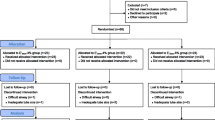Abstract
To investigate the effects of four volatile anesthetics (halothane, enflurane, isoflurane, and sevoflurane) on postanesthetic ventilation and levels of consciousness, we enrolled 24 patients undergoing tympanoplasty in this study. Anesthesia was maintained with 67% nitrous oxide and one of four volatile anesthetics. We measured end-tidal carbon dioxide concentration (CETco2), minute volume (\(\dot V_E \)) and respiratory rate (RR), and determined the volatile anesthetic concentration in whole arterial blood (CBAnesth) and arterial carbon dioxide tension (Paco2) at 20 min and 2h after tracheal extubation. We also observed the level of consciousness (awake, drowsy, and asleep) before the measurement. Ventilatory variables were similar among the four groups at 20 min, although the ratio of volatile anesthetic concentration in the alveoli to the minimum alveolar concentration (MAC) (CAAnesth/MAC ratio) calculated from CBAnesth in the halothane group was twice those in the other groups. In the halothane group, Paco2 was significantly higher, and\(\dot V_E \) and RR were significantly lower compared with the isoflurane and sevoflurane groups at 2h. Halothane tended to prolong the recovery of levels of consciousness. We conclude that isoflurane and sevoflurane provide clinical advantages over halothane on postanesthetic ventilation and recovery of levels of consciousness.
Similar content being viewed by others
References
Eager II EI (1981) Isoflurane: A review. Anesthesiology 55:559–576
Wallin RF, Regan BM, Napoli MD, Stern IJ (1975) Sevoflurane: A new inhalational anesthetic agent. Anesth Analg 54:758–765
Doi M, Ikeda K (1987) Postanesthetic respiratory depression in humans: A comparison of sevoflurane, isoflurane, and halothane. J Anesth 1:137–142
Miwa Y, Kurata Y, Yamaji A, Hiraoka E, Tomi K, Tashiro C, Yoshiya I (1987) Therapeutic drug monitoring for the volatile anesthetics (in Japanese), J Clin Anesth 11:677–678
Yokota T, Hitomi Y, Ohta K, Kasaka F (1967) Direct injection method for gas chromatographic measurement of inhalation anesthetics in whole blood and tissues. Anesthesiology 28:1064–1073
Yamada Y, Nishimoto M, Seto K, Iijima M, Itano Y, Kimura S, Kakeda A, Hirakawa M, Kosaka F (1982) Measurement of blood levels of anesthetic agents by gas chromatography: I. An improved method for direct analysis of the concentration of halothane dissolved in blood. Masui (Jpn J Anesthesiol) 31:36–44
Bridges Jr BE, Eger II EI (1967) The effect of hypocapnea on the level of halothane anesthesia in man. Anesthesiology 28:634–637
Gion H, Saidman LJ (1971) The minimum alveolar concentration of enflurane in man. Anesthesiology 35:361–364
Stevens WC, Dolan WN, Gibbsons RT, White A, Eger EI-II, Miller RD, DeJong RH, Elashoff RM (1975) Minimum alveolar concentration (MAC) of isoflurane with and without nitrous oxide in patients of various ages. Anesthesiology 42:197–200
Scheller MS, Saidman LJ, Partridge BL (1988) MAC of sevoflurane in humans and the New Zealand white rabbit. Can J Anaesth 35:153–156
Katoh T, Suguro Y, Ikeda T, Kazama T, Ikeda K (1993) Influence of age on awakening concentration of sevoflurane, and isoflurane. Anesth Analg 76:348–352
Inagaki Y Mashimo T, Kuzukawa A, Tsuda Y, Yoshiya I (1994) Epidural lidocaine delays arousal from isoflurane anesthesia. Anesth Analg 79:368–372
Katoh T, Suguro Y, Kimura T, Ikeda K (1993) Cerebral awakening concentration of sevoflurane and isoflurane predicted during slow and fast alveolar washout. Anesth Analg 77:1012–1017
Eger II EI (1994) Uptake and distribution. In: Miller RD (ed) Anesthesia. Churchill Livingstone. New York, p 102
Inagaki Y, Kuzukawa A, Mashimo T, Yoshiya I (1994) Low plasma lidocaine concentration does not affect oxygen uptake at awakening from isoflurane anesthesia. Anesth Analg 78:531–535
Author information
Authors and Affiliations
About this article
Cite this article
Inagaki, Y., Tashiro, C., Miwa, Y. et al. Effects of four volatile anesthesics on postanesthetic ventilation: a comparison of halothane, enflurane, isoflurane, and sevoflurane. J Anesth 10, 99–104 (1996). https://doi.org/10.1007/BF02483343
Received:
Accepted:
Issue Date:
DOI: https://doi.org/10.1007/BF02483343




